![]()
Extended reality (XR) is an exciting new technology that has the potential to revolutionize the way we teach and learn. By creating immersive learning experiences that combine the real world with digital materials or fully simulated environments, XR can help students better understand complex topics and retain information more effectively. In this article, we’ll explore how you can use Extended Reality (XR) in education to create immersive learning experiences for your students.
We’ll cover what XR is, the benefits of using XR in education, and provide examples of how XR is currently being used in education. We’ll also provide a step-by-step guide on how to create immersive learning experiences with XR.
Table of Contents
- What is Extended Reality (XR)?
- Benefits of Using Extended Reality (XR) in Education
- Examples of XR in Education
- Tips for integrating XR into the curriculum
- How to Create Immersive Learning Experiences with XR
- Challenges when implementing XR in education
- Cost of implementing Extended Reality (XR) in education
- How to get funding for implementing XR in education
- Frequently Asked Questions (FAQs):
- Q: What types of XR technology can be used in education?
- Q: What hardware and software is needed to use XR in education?
- Q: What are some best practices for using XR in education?
- Q: Are there any case studies of successful implementations of extended reality (XR) in education?
- Q: What is the future of Extended Reality (XR) in education?
- Conclusion
What is Extended Reality (XR)?
Extended Reality (XR) is an umbrella term that encompasses virtual reality (VR), augmented reality (AR), and mixed reality (MR). VR immerses users in a fully simulated environment, while AR overlays digital objects onto the real world. MR combines elements of both VR and AR to create a hybrid experience.
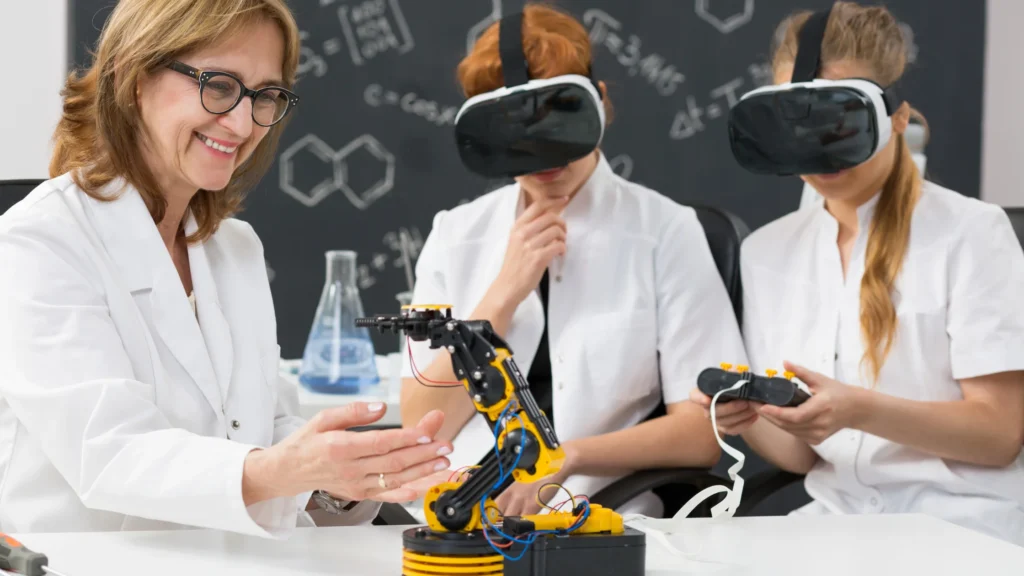
Benefits of Using Extended Reality (XR) in Education
There are many benefits to using XR in education. For example:
- Increased engagement: XR can help students become more engaged with the material by providing a more interactive and immersive learning experience.
- Improved retention: Studies have shown that students who learn through immersive experiences are more likely to retain information than those who learn through traditional methods.
- Enhanced understanding: By creating immersive learning experiences that combine the real world with digital materials or fully simulated environments, students can better understand complex topics.
- Safe practice environment: XR can provide a safe and controlled environment for students to practice skills and procedures that may be dangerous or difficult to replicate in the real world.
- Collaboration: XR can facilitate collaboration between students, allowing them to work together on projects and assignments in a virtual environment.
- Accessibility: XR can make learning more accessible by allowing students to experience environments and situations that may be difficult or impossible to access in the real world.
- Personalization: XR can provide personalized learning experiences that adapt to the needs and abilities of individual students.
- Motivation: XR can increase student motivation by providing a fun and engaging way to learn.
Examples of XR in Education
There are many examples of how XR is currently being used in education. Here are just a few:
- Virtual field trips: With XR, students can take virtual field trips to places they might not otherwise be able to visit.
- Simulations: XR can be used to create simulations that allow students to practice skills in a safe and controlled environment.
- Interactive textbooks: By overlaying digital objects onto physical textbooks, XR can make learning more interactive and engaging.
- Language learning: XR can be used to create immersive language learning experiences that allow students to practice speaking and listening skills in a virtual environment.
- Historical reenactments: With XR, students can experience historical events and locations in a more immersive and engaging way.
- Science experiments: You can use XR to create virtual science experiments that allow students to explore scientific concepts in a safe and controlled environment.
- Art and design: With XR, students can create and manipulate 3D objects in a virtual environment, allowing them to explore their creativity in new ways.
- Medical training: You can use XR to create realistic simulations that allow medical students to practice procedures and diagnose conditions in a safe and controlled environment.
Tips for integrating XR into the curriculum
Here are some tips for integrating XR into your curriculum:
- Start small: Begin by introducing XR technology into one or two lessons to see how it works and how your students respond.
- Choose the right software: Make sure to choose software that is appropriate for your subject matter and that is easy for you and your students to use.
- Provide training: Make sure to provide training for both yourself and your students on how to use the XR technology.
- Set clear learning objectives: Make sure to set clear learning objectives for each lesson that incorporates XR technology.
- Evaluate and adjust: After using XR technology in your lessons, evaluate its effectiveness and make any necessary adjustments to improve the learning experience for your students.
How to Create Immersive Learning Experiences with XR
Creating immersive learning experiences with XR is easier than you might think. Here’s a step-by-step guide:
- Analyze different topics where students need firm foundational learning.
- Understand and depict the complexity of each topic as well as the type of experience that would add value.
- Define and establish milestones for understanding each topic and define the assessment criteria for each experience.
- Provide the necessary KT (Knowledge Transfer) to your extended reality team to develop the experience.
When creating your immersive learning experience, be sure to use keyword rich text for links. This will help improve your search engine rankings and make it easier for your audience to find your content.
Challenges when implementing XR in education
There are several challenges that educators may face when implementing XR in education. Some of these challenges include:
- Cost: Implementing XR in education can be expensive, as it requires investment in hardware, software, and content development.
- Technical expertise: Educators may need to acquire new technical skills and knowledge to effectively implement and use XR technology in their classrooms.
- Accessibility: Not all students may have access to the necessary hardware and software to participate in XR learning experiences.
- Integration with curriculum: Educators may face challenges in integrating XR technology into their existing curriculum and lesson plans.
- Student engagement: While XR can be engaging and immersive, it may not be effective for all students. Educators may need to find ways to engage all students and ensure they benefit from the XR learning experience.
Cost of implementing Extended Reality (XR) in education
The cost of implementing XR in education can vary depending on several factors such as the number of devices and licenses needed, the type of software used, and the amount of content production required.
One cost to consider is the cost of an Extended Reality System (XRS), which helps organizations manage their XR content and users. The total cost of an XRS will depend on the number of licenses purchased, which typically run between $10 – $30 per month or more. You’ll need to account for one license per device and a baseline fee for a web-accessed portal. A software subscription often adheres to economies of scale; the more licenses you purchase, the less you pay per license.
Other costs to consider include the cost of VR headsets, content production, and software development. It’s important to carefully evaluate your needs and budget when considering implementing XR in education.
How to get funding for implementing XR in education
There are several ways you can get funding for implementing XR in education. One way is to apply for grants from organizations that support the use of XR technology in education.
For example, Unity offers a Higher Ed XR Innovation Grant that is intended to empower colleges and universities to support learners in expanding their professional and income-earning opportunities through training in XR development with Unity.
EON Reality also offers a K-12 XR Grant Program for Post-Pandemic Recovery Assistance that provides elementary, middle, and high schools support to fund the launch of new virtual reality and augmented reality (XR) programs in the post-pandemic world.
Another way to get funding for implementing XR in education is to seek support from your school or district administration. You can make a case for the benefits of using XR technology in education and request funding to support its implementation.
You can also explore crowdfunding options or seek support from local businesses or community organizations that may be interested in supporting the use of innovative technology in education.
Frequently Asked Questions (FAQs):
Q: What types of XR technology can be used in education?
A: You can use three main types of XR technology in education: Virtual Reality (VR), Augmented Reality (AR), and Mixed Reality (MR). VR creates a fully immersive virtual environment, AR overlays digital objects onto the real world, and MR combines elements of both VR and AR.
Q: What hardware and software is needed to use XR in education?
A: The hardware and software you need to use XR in education depends on the type of XR technology you use. For example, VR typically requires a VR headset and a computer or gaming console with sufficient processing power. Also, you can often experience AR using a smartphone or tablet with an AR app. There are also many software options available for creating and experiencing XR content in education.
Q: What are some best practices for using XR in education?
A: Some best practices for using XR in education include starting small by introducing XR technology into one or two lessons, choosing the right software that is appropriate for your subject matter and easy to use, providing training for both yourself and your students on how to use the XR technology, setting clear learning objectives for each lesson that incorporates XR technology, and evaluating and adjusting your use of XR technology based on its effectiveness.
Q: Are there any case studies of successful implementations of extended reality (XR) in education?
A: Yes, there are many case studies of schools and educational institutions that have successfully implemented XR technology. These case studies often highlight the positive impact that XR technology has had on student engagement, retention of information, understanding of complex topics, and overall learning outcomes.
Q: What is the future of Extended Reality (XR) in education?
A: The future of XR in education is very promising. As the technology continues to advance and become more accessible, it is likely that we will see even more innovative and effective uses of XR in education. Additionally, this may include more personalized and adaptive learning experiences, greater collaboration between students and teachers, and new ways to assess student learning.
Conclusion
XR has the potential to revolutionize the way we teach and learn by creating immersive learning experiences that combine the real world with digital materials or fully simulated environments. By following these tips, you can create immersive learning experiences that are engaging, effective, and relevant to your students. If you liked this article, we recommend that you also check out our blog post titled, The Metaverse: What, How, and its Potential for Education and Top Free Metaverse Platforms for Teachers.
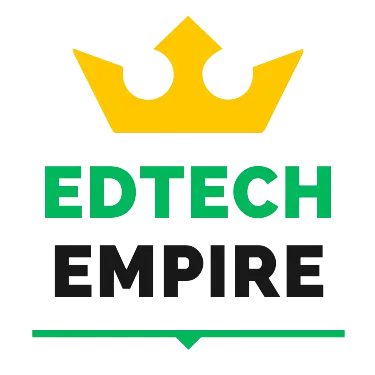
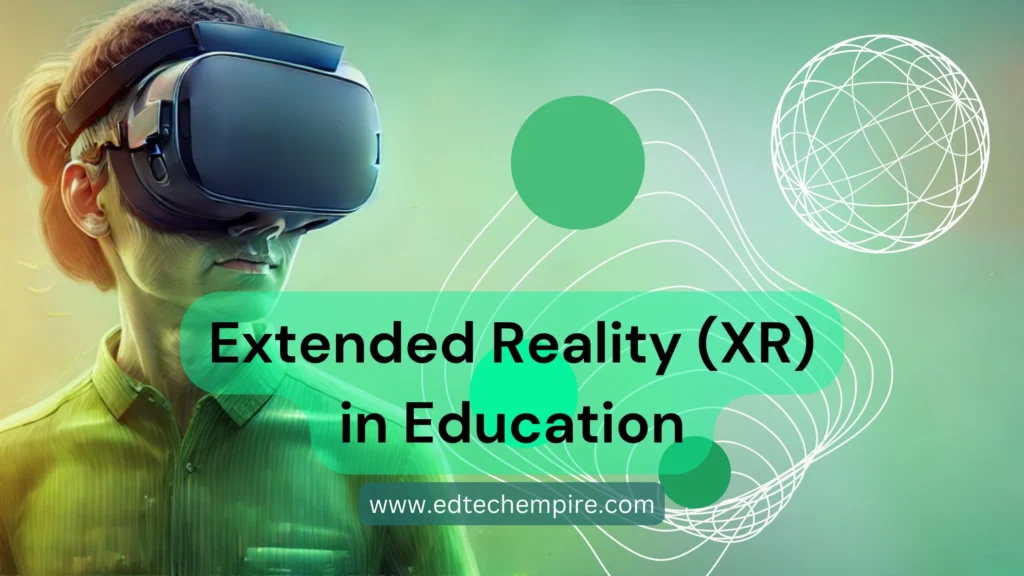
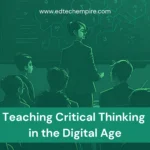
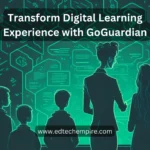
The power of extended reality in education – a gateway to experiences that ignite wonder and transform abstract concepts into vivid, touchable realities. A child struggling with ancient history no longer just reads about the Roman Forum; she walks through it, watching toga-clad senators debate while the Mediterranean sun warms her virtual skin. A medical student’s heart races with a mixture of excitement and focus as she practices a delicate surgical procedure, knowing she can try again and again until her movements become second nature, each attempt building confidence without risk. In design studios, students reach out to mold virtual clay with their hands, their creative visions taking shape in mid-air as naturally as breathing.
These aren’t just lessons – they’re journeys that forge emotional connections to learning, creating memories that embed themselves deep in the mind and heart. Through extended reality, education becomes more than the transfer of information; it becomes an adventure that sparks joy, curiosity, and the profound delight of discovery.
You can browse some the best learning experience by school subject at the Xr School website. http://www.thexrschool.com